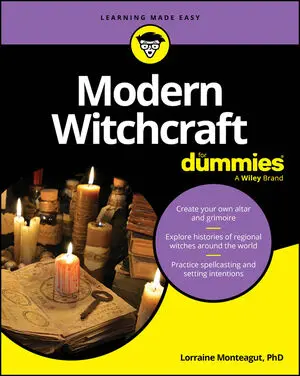Articles & Books From Wicca & Witchcraft
A contemporary guide to the roots, paths and tools of witchcraft. A new generation of witchcraft is here! Today, witchcraft encompasses many different paths and is one of the most rapidly growing sets of spiritual systems in the world. Modern Witchcraft For Dummies walks you through what it means to be a modern witch—going beyond the Euro-pagan traditions and Wicca—and how to ensure your witchcraft moves toward inclusivity and spiritual activism.
Cheat Sheet / Updated 02-16-2022
Wicca, a sect of witchcraft, is centered in ritual that Wiccans perform for specific purposes, such as communicating with or honoring Deity. The sabbats are Wiccan solar holidays focused on the Earth's path around the sun, sometimes referred to as Wheel of the Year. Esbats are Wiccan lunar holidays that focus on the moon's cycle.
Article / Updated 03-26-2016
Some people cautiously hide their beliefs and never tell others about their involvement in Wicca — not their families, not their friends, and certainly not their employers. They hide their altars, keep their books hidden in drawers instead of displayed on shelves, and find an excuse to leave in a hurry when people start talking about religion.
Article / Updated 03-26-2016
Did Wicca and Witchcraft exist throughout history? People in many fields of study have been debating this issue for decades. No definitive answers have surfaced. Wiccans and others usually believe and promote one of three explanations about Wicca: Wicca is a new form of spirituality that re-creates some older practices and ideas.
Article / Updated 03-26-2016
Wiccans who are successful and effective, both in their spiritual and general lives, tend to have some coping skills and lifestyle choices in common. These practices and paths are far from odd or eccentric — just often missed amid the haste of everyday business. Grounding Grounding power or Earthing power means to connect personal energy with the Earth.
Article / Updated 03-26-2016
A four-leaf clover for luck. The suit that you always wear to job interviews for success. The ring you never take off because it represents your love for another person. The pendent you wear around your neck every day for protection. The small statue hanging from the rearview mirror of your car for safe travel.
Article / Updated 03-26-2016
The Wiccan view of an interconnected world isn't just a mystical, spiritual notion. Modern science, especially cutting-edge ideas in quantum physics, supports the ideas of life's interconnection and interdependence. The following are some of the leading theories that blend perfectly with Wiccan belief. Going quantum: Matter versus energy People see the physical world as a bunch of independent and stable objects, but that's not exactly the truth.
Article / Updated 03-26-2016
Wiccan holidays, or Sabbats, are timed to the seasons and the Earth's natural rhythms. Sabbats celebrate the Earth's journey around the sun, called the Wheel of the Year, and Wiccans refer to commemorating the Sabbats as Turning the Wheel. Most Wiccans celebrate these eight Sabbats annually: Yule, Winter Solstice: December 20, 21, 22, or 23 Yule is the longest night and the shortest day of the year.
Article / Updated 03-26-2016
The Esbats, or Wiccan lunar holy days, celebrate the moon's passage around the Earth. The Esbats offer Wiccans a chance to regularly put aside time to step away from the ordinary world and dedicate time to spiritual reflection or magical work. The approach to the holy days isn't all-inclusive. For each phase of the moon, some groups have particular rituals, and the Esbats can be celebrated by individuals or covens.
Article / Updated 03-26-2016
For Wiccans, ritual is a ceremony performed for a specific purpose such as feeling a connection to Deity, and the essence of Wicca. During ritual, Wiccans honor or worship the Divine, many work magic, and participants search their hearts and spirits letting the ritual evolve naturally. The following list shows the basic steps for a practicing a Wiccan ritual: Decide why you want to conduct a ritual.

